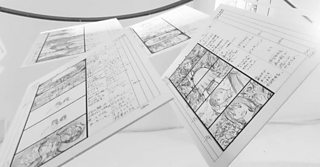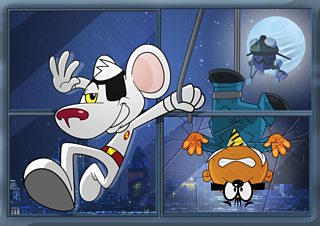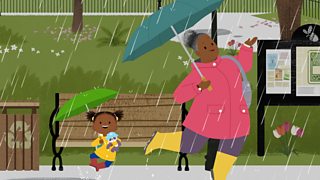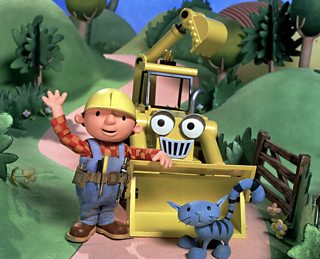Writing for Animation: It’s better than a proper job
Andrew Burrell
Script Editor/ Writer
I used to have proper jobs. I sold office furniture in a freezing warehouse on a very grey trading estate in Birmingham. I hired out machinery to building companies and sniggered every time someone ordered a ‘vibrating poker’ – it’s a real thing, look it up. I taught very hands-on construction students the boring bits of their courses that didn’t involve their hands. Before that I’d left school at 16 with a single passable GCSE in ‘Keyboard Applications’, a subject long consigned to the least interesting annals of academic history. Basically, it meant I could touch-type. Turns out that was much more useful than Maths, which I did pass eventually at a college, along with English. There I had a great teacher who encouraged me to do a bit of writing. I’d always written for “fun”, if that’s what you call it, and ended up doing a 6-year part-time degree in creative writing whilst working fulltime. That’s where I saw a script for the first time. And everything clicked. I’d found a way I could express the annoying voice in my head that felt natural to me. Off the back of that, I managed to blag my way onto a MA Scriptwriting course at Goldsmiths and then blundered into a trainee position in telly. Eleven years ago, I stumbled, tripped, and fell into the world of animation writing. Since then, I’ve screwed a load of things up, done some things right and made loads of creative friends. I try to share what I’ve learned with anyone else who fancies doing this stuff because any successes I’ve had are due to the generosity of other people lending their experience and support.
I always add two caveats to anything I try and pass on. One, I might be lying, or just plain wrong; so don’t believe anything you’re reading here unless it’s useful to your own journey through the industry. There are, in the wide world of writing, more ‘script doctors’, ‘gurus’ and ‘experts’ willing to relieve you of your cash than there are writers. Some are great, some are not. Be suspicious of false prophets. I cherry-pick useful bits of information and technique from whatever I read or see. It seems to work.
Second caveat (is it a caveat?): there is money to be made! Yes, that’s right. You can come down from your damp, attic garret. You can stop hiding from the TV licence guy. You can buy the branded cereal and not the slightly wrong own brand stuff. Breaking into ‘writing’ in any form is hard; mainly because opportunities are limited, and competition is fierce. You can make a living in animation writing because there are more opportunities. Traditional series tend to have LOADS of episodes. A run of 52 has been the norm and that requires a lot of writers. That’s maths. Another bit of maths to be aware of is initial writer’s fees for animation writing are a bit rubbish compared to its live-action sibling. BUT animation is easily dubbed, travels internationally and residual payments mount up over time. The – your new best friend as a new writer, google them - collect this money for you and it can end up being more than the initial fee. I’d like to take this opportunity to thank the people of Latvia for continuing to appreciate the terrible jokes I wrote ten years ago.

Animation storyboards
Caveats over, the first big lesson about animation writing I like to pass along the line was learnt at a job interview with the Βι¶ΉΤΌΕΔ. The magnificent , an exec at CΒι¶ΉΤΌΕΔ, asked me a straightforward question: ‘What can you tell me about the animation landscape at the moment?’. In my head I was thinking, ‘Landscapes? That’s like trees and stuff? They are nicely drawn?' Guess what, that wasn’t what she was on about. She was testing my non-existent awareness of what’s going on in the animation industry. In that moment, I realised I really should have done a bit of research into which companies are out there doing cool stuff. Which channels/streamers broadcast what kind of things? And, most importantly, what are the audience into? Audience awareness was my second big lesson. I didn’t have any and to do a proper job, I needed a lot.
In my binary head, there are two ways of looking at any kind of writing. It’s either all about me, the tortured artist OR it’s all about the audience; AKA the skynet ‘algorithm’ AKA being a ‘hack’ writer. My binary head is wrong and needs to shut up. Writing is a communication that needs two parties to be meaningful. A writer and an audience. It’s a bit of tortured artist and a bit of skynet. If you like just doing the tortured artist bit, that’s all cool. Lock yourself away and scream into a mirror. If you want to connect with other humans then you need to bring ‘yourself’ to any creative project, but also balance your own interests, style and understanding with the expectations and needs of the audience. When I’m not poncing about in my beret thinking I’m the next Shakespeare, I’m trying to suss out what the audience are interested in seeing. That’s not hard. Ask them or turn on the telly or boot up youtube and see what’s there. Animation has consistently been the most watched genre/medium for young audiences. Is it a genre? Is it a medium? I dunno, but children love it. And in the UK children will be your primary audience for animation writing. Particularly pre-school. There’s a lot of it. One of the main reasons for getting to know that audience is, the way they watch is probably different to yours as an adult.

Danger Mouse and Penfold
Audience behaviour is a moving target, changing constantly and that impacts format and form. Children have already left the building when it comes to television. They are more likely to be on youtube than a traditional TV channel. It’s a fact. We can all weep and wail, but good writers adapt.
An interesting thing that the rise of youtube and the streamers has led to is the length of animation content becoming much more flexible. Traditionally you’ve had 11 minute and 22 minute shows. These were described as international half hours and quarter of an hours. Probably should have been called the formats with loads of room for adverts. I’ve seen recently commissions for 6 minutes, 2 minutes, 4 minutes, 35 minute episodes. All sorts. As a writer, that’s kind of cool because you can experiment with the type and style of story you tell. Some stories demand longer lengths, others don’t. Animation is always ‘efficient’ in its storytelling because every frame costs loads of money to make but there are definitely opportunities to push boundaries and have some fun. Older-skewing animation and animation for adults tend to still fit into the half hour-ish format. Maybe that’s because the audience grew up with that? Maybe it’ll change as the current audience gets older? If you are looking at audiences for animation, one thing that’s very clear is adult animation is having a proper full scale sonic boom. One question I get asked a lot is why doesn’t adult animation get made in the UK? I don’t know for certain, but I can come up with a half-baked theory as well as anyone else and here it comes.

JoJo & Gran Gran
Adult animation hasn’t traditionally had a foothold in the UK. There’s been a few valiant attempts but not much has stuck. ‘Cartoons’ are still considered a ‘kids’ thing’. Maybe this is because we haven’t had our ‘Simpsons Moment’ yet? That show changed everything in the United States; kicking the door off the hinges for everyone from ‘South Park’, ‘Archer’ to ‘Rick and Morty’ to pile in behind. If you’re reading this and have the UK’s ‘Simpsons’ please hurry up and kick the door off the hinges so I can jump on your coat tails. No pressure. I’m sure we’ve got the skills in the UK to write and produce adult animation. I’ve been fortunate enough to work on an adult animated show for Netflix in the U.S. and there’s no dark alchemy going on. They are doing for that audience what we’re doing for the younger one. Sort of. They do sometimes work in different ways and on my first day of that gig I had a hard lesson about working methods that slapped me right in my pompous chops.

Picture the scene: a fancy office opposite Malibu beach; the sun is shining, you can hear the waves of the Pacific Ocean creeping up and down the sand, you’re sitting at a conference table with Matt Groening, David X Cohen, Josh Weinstein, Shion Takeuchi, Reid Harrison, Jeff Rowe, the very lovely Rich Fulcher – he is spectacularly lovely – and a bunch of other writers who are proper Champions League level. You’ve been doing this animation writing for nearly a decade. You know what you are doing. Don’t mind the jetlag and the fact you’re having a dissociative, out of body experience. This will be fine. Cut to ten minutes later: What the hell is going on? What are these people talking about? Where’s the series bible? I DON’T KNOW WHAT I’M DOING!! Should I fake a heart attack to save face? Probably not the best idea. A better one would be to shut up, keep your ears and eyes open and appreciate that their process is different to what you’re used to.
The lesson I learned that day, between excessive trips to the toilet, was every animation writing process is setup differently. I was only aware of the traditional UK writer driven model. Here, as a writer, you are commissioned, usually get some kind of writers’ bible with details of the show, roll up to a conference with the other writers for a few days to chuck about ideas, and then disappear back to your self-inflicted social isolation to bang out your work. You get notes in your inbox or down the phone which you smile politely to and then rage about on your own time. The Malibu experience was a ‘room model’. A bunch of people are embedded in the production, sit in a room for months or even a year and work as a team, drink a lot of coffee, primarily focus on what to order for lunch and through a weird controlled osmosis manage to write and produce a show. There are also ‘Board-Driven’ shows like the excellent UK based ‘Adventures of Gumball’ or the utterly amazing ‘Adventure Time’. Those are usually showrun by some kind of savant genius who ‘draws’ out the show rather than having a traditional script process. And there’s also any other number of hybrid systems which have elements of all the above.
The big lesson for me from my American experience was: there’s more than one way to ‘write’ an animated show, so don’t try and wedge yourself into one particular model. If you are a super talented artist, as well as a writer, use those skills. I can’t draw a convincing stick man, so I focus on scripts but from my experience the animation industry is particularly flexible in working methods. It encourages innovation arguably more than any other forms of writing? I’ll get slaughtered for that comment. Whatever. Do what works for you.

Bob the Builder
I could bang on about many other things I’ve learned, unlearned and screwed up along the way; but that’s for another time. Hopefully, you’re catching the vibe that writing for animation is hard and takes a lot of thought but is kind of fun. It’s also achievable as a ‘career’. There are so many barriers to writing as a job, unless you are already well off or have the privilege of traditional connections. Animation is open to new voices and literally new ways of looking at the world. It needs that diversity of voice and vision to survive. It’s a good place to be; populated by some very smart, very talented and very lovely people. Give it a go. You might like it. It’s definitely better than a proper job and if it all goes pear-shaped then you can go back to that later. Good luck.
